Hello all, working on converting a 12x16 building into a home theater/home office sort of room, and I'm pre-wiring all the speaker wiring while i have the walls open and bare before insulation. I find that most subwoofers use phono/RCA type inputs, and the wall plate i picked up here has phono/RCA jacks on it for the sub(s) output.
Since this wall plate will be in the middle of one of the shorter walls, I am only going to need to run maybe six feet total between the surround sound wall plate to each individual speaker located plate. My question here is what to use for the internal wall wiring. Would RG6 quad shield with an RCA female on either end be appropriate, or would i want to use something else? I have seen some recommend to use simple sheilded thermostat wire with solderless RCA adapters on either end, similar to thermostat or CCTV wiring. I've also been told to use CAT5 with baluns, but that seems excessive and unnecessary.
I have enough RG6 on hand, as well as some sheilded thermostat cable. I even have CAT5E in a bulk box on hand as well.
Any input from y'all? I just want to avoid any issues here since I can easily do it the right way now.
Since this wall plate will be in the middle of one of the shorter walls, I am only going to need to run maybe six feet total between the surround sound wall plate to each individual speaker located plate. My question here is what to use for the internal wall wiring. Would RG6 quad shield with an RCA female on either end be appropriate, or would i want to use something else? I have seen some recommend to use simple sheilded thermostat wire with solderless RCA adapters on either end, similar to thermostat or CCTV wiring. I've also been told to use CAT5 with baluns, but that seems excessive and unnecessary.
I have enough RG6 on hand, as well as some sheilded thermostat cable. I even have CAT5E in a bulk box on hand as well.
Any input from y'all? I just want to avoid any issues here since I can easily do it the right way now.
I would never use RCA connectors in a permanent installation (it would unpermanent(?) the install).
You did not mention if the system will use active or passive speakers, E
You did not mention if the system will use active or passive speakers, E
RG6 quad shield is often the type that cable TV installers use. If the coax has a foil shield (and a few strands of braid) it's a poor choice for analog audio cables.
This will be for supplying the signal to active/powered subwoofers, not the speaker level output. The wall plate I linked features RCA jacks for the signal feed to remote powered/active subwoofers. I'm likely going to build subwoofer kits, or purchase Dayton powered subwoofers that require input via RCA jacks, as I will be running an active crossover to split off signal to the subwoofer(s).I would never use RCA connectors in a permanent installation (it would unpermanent(?) the install).
You did not mention if the system will use active or passive speakers, E
All the other speakers will be wired to binding posts on wall plates, with internally wired speaker cable inside the walls, and a short interconnect from the binding posts on the wall plate to the speakers themselves. That part is already figured out and mostly finished.
RG6 quad shield is often the type that cable TV installers use. If the coax has a foil shield (and a few strands of braid) it's a poor choice for analog audio cables.
For the subwoofer signal level, looking at most of the home theater guy discussions and AV forums, it looks like RG6 quad shield is used a great deal for this, as it's only a low frequency analog signal- the high capacitance being a non-issue here. In my experience locally its a very commonly used cable for pre-wiring lines for active subwoofers as well, with no loss in quality at the frequency range needed.
RG6 quad shield should be fine for subwoofer use though it is stiff and difficult to terminate for audio as the braid is usually aluminum and will not accept solder (the center conductor may as it is copper-clad steel). Also, the plastic insulating materials melt easily. It requires a compression or screw-on (not recommended) termination. Compression F-connectors for RF use are plentiful, RCAs less so. There are F-to-RCA adapters but that adds connections. A quick look shows that RG6 cables pre-terminated with male RCAs are easily available if you can find the proper lengths you need. I do not see a link to the wall plates. What, exactly, is on the rear (inside wall) of the plate for the RCAs? Female RCAs? @mickeymoose is correct that RCAs are not the best as they can pull out easily. Of course, that is true of the in-house subwoofer connection as well. I used XLR connectors in my home but they are large and expensive.
Many inexpensive audio cables used to use RG-59. It is also a 75 ohm RF cable. It is smaller diameter and usually has copper conductors and better braid coverage than RG6. Pretty much obsolete now.
Here's the link- https://a.co/d/4x7dPyDRG6 quad shield should be fine for subwoofer use though it is stiff and difficult to terminate for audio as the braid is usually aluminum and will not accept solder (the center conductor may as it is copper-clad steel). Also, the plastic insulating materials melt easily. It requires a compression or screw-on (not recommended) termination. Compression F-connectors for RF use are plentiful, RCAs less so. There are F-to-RCA adapters but that adds connections. A quick look shows that RG6 cables pre-terminated with male RCAs are easily available if you can find the proper lengths you need. I do not see a link to the wall plates.
And some pics- simple RCA connection on the back and front of the plate for the subwoofer, I'm not planning on a rear center channel, but might add two more RCAs in those binding post positions for additional remote sub locations to future proof things-What, exactly, is on the rear (inside wall) of the plate for the RCAs? Female RCAs? @mickeymoose is correct that RCAs are not the best as they can pull out easily. Of course, that is true of the in-house subwoofer connection as well. I used XLR connectors in my home but they are large and expensive.
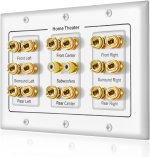
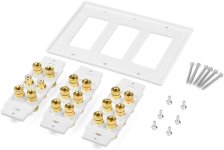
I do have a professional Belden compression tool (I'm a former commercial installation tech for several cable internet/phone/television providers) to properly install the correct F connectors, and I do see that I can use either RCA to F adapters (functional, but clunky) or I could also replace the provided RCA connectors with ones that feature an F connector on the backside, like these, this would eliminate a converter-
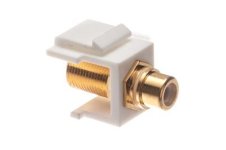
Another alternative I suppose would be to use crimp-on RCA connectors with the RG6, but I need to see if my compression tool will work with RCA type center conductors on the connectors.
I would strongly advise twisted shielded pair cabling for line-level balanced lines. You don't know if you need it. Compared to replacing wire after the wall is closed it is cheap. Hum would take the joy out of your new home theater install. E
I'm not installing anything with a balanced signal, how will sheilded, twisted pair benefit me for a single ended signal?
I'd probably use something like Mogami W2534 or W2893 quad mic cable, one per channel, for that. That way if you ever did need to go balanced, you'd have the conductors to do so.
Well, I found a spool of this stuff in my stash while looking for something completely unrelated, I think I'll use this, as it should cover me for any future balanced setup too since it's only running about six feet per run.
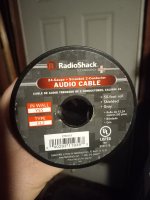
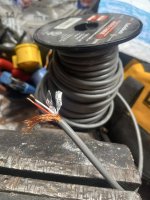
It's CL2 rated for in-wall use, and has nice quality jacketing material, braid, and foil.


It's CL2 rated for in-wall use, and has nice quality jacketing material, braid, and foil.
“It's CL2 rated for in-wall use, and has nice quality jacketing material, braid, and foil.”
That should do the trick!
That should do the trick!
Also, just to be safe, i'll be running one more speaker cable along with these as well, that will give me the option to run a triamp setup with individual amplifiers, with the option for a passive or powered sub at the front left and right locations. Should cover all eventual options.
It has nothing to do with total cable capacitance.For the subwoofer signal level, looking at most of the home theater guy discussions and AV forums, it looks like RG6 quad shield is used a great deal for this, as it's only a low frequency analog signal- the high capacitance being a non-issue here. In my experience locally its a very commonly used cable for pre-wiring lines for active subwoofers as well, with no loss in quality at the frequency range needed.
It's about 'Common Impedance Coupling Noise" currents. Which are power line related. (Hum & buzz).
an RCA analog interconnect cable more than about say 10 feet (3 meters) long should have a heavy braided shield.
Bill Whitlock retired from Jensen Transformers often writes about this problem.
Years ago, I bought a roll of "22-4 sound and security wire" from the home improvement store. I have used it for lots of things but I still have most of it. It has a foil shield so it's actually 5 conductors. I don't see it online anymore, but it was not more than $20 for a 150' roll, before the price of copper went crazy.
Similar to 8723:
https://catalog.belden.com/techdata/EN/8723_techdata.pdf
But a friend had a better idea, ie run a ~plastic pipe/ conduit and pull in whatever wire you need after the wall are built.
Similar to 8723:
https://catalog.belden.com/techdata/EN/8723_techdata.pdf
But a friend had a better idea, ie run a ~plastic pipe/ conduit and pull in whatever wire you need after the wall are built.
Last edited:
The shield is not considered a conductor for a signal, only a grounded shield (grounded on one end only). Otherwise any info on the shield will be superimposed onto the actual signal conductors.
For this reason you should (must) not have mike-level, line-level and speaker-level conductors in the same conduit or even running in close proximity parallel to each other.
E
For this reason you should (must) not have mike-level, line-level and speaker-level conductors in the same conduit or even running in close proximity parallel to each other.
E
I was caught off guard once by a home intercom company that sells "magic" cable for their systems. The trick is that the cable is 3 conductor zip wire where the center is ground, and one side is an unbalanced input while the other side is the output. the only way to replace this special wire is with two separately shielded conductors, ie ~=8723.
True for balanced interconnects, microphone cables and speaker cables.The shield is not considered a conductor for a signal, only a grounded shield (grounded on one end only). Otherwise any info on the shield will be superimposed onto the actual signal conductors.
But for RCA interconnects, the best choice is a coax cable and the shield is the return signal conductor.
- Home
- Design & Build
- Construction Tips
- Remodel - What type of cable for in-wall phono/RCA plug subwoofer wiring?